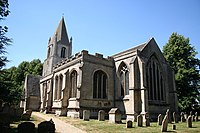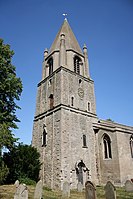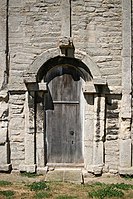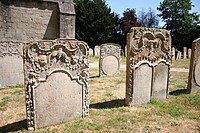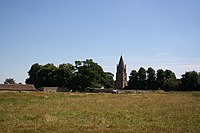Barnack Church
| Church of St John the Baptist, Barnack | |
|
Barnack, Northamptonshire | |
|---|---|
| Status: | parish church |
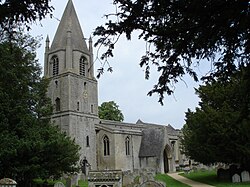 St John the Baptist's Church, Barnack | |
| Church of England | |
| Diocese of Peterborough | |
| Location | |
| Grid reference: | TF079050 |
| Location: | 52°37’57"N, 0°24’25"W |
| History | |
| Information | |
| Website: | Barnack Parish Church |
The Church of St John the Baptist, Barnack is the Church of England parish church in the village of Barnack in the Soke of Peterborough, Northamptonshire. The tower and possibly other parts of the church are Anglo-Saxon church, and a fine example of the church architecture of that age in a county with more than its fair share of Saxon churches. It is built, as is the whole village, in the local stone, Barnack rag, a beautiful honey-coloured limestone quarried in the village.
The church is a Grade I listed building.[1]
The church is dedicated to John the Baptist. The Anglo-Saxon tower is the most noteworthy feature of the church. It was built around the year 1000, the reign of Ethelred the Unready, and around 1200 a spire was added, which itself it possibly one of the earliest spires in Britain.[2] The tower has a number of typically Saxon features, including pilaster strip work, a sundial, a carved panel and three carved birds. Inside, the tower opens to the nave by a magnificent Saxon arch.
The bulk of the nave is more recent; of the 112th and earluy 13th centuries. In the north aisle is a large Romanesque sculpture of a seated Christ in Majesty that was discovered under the floor in 1931. Estimates of the date of the Christ vary widely, from the latter part of the 10th century to around 1200; the Corpus of Romanesque Sculpture in Britain and Ireland settles on the late 12th century.[3]
Simon Jenkins gives the church four stars in his England's Thousand Best Churches (1999) and highlights as features the tower, the stiff-leaf font and the Christ in Majesty.
Pictures
-
St John from the southeast showing the Lady Chapel
-
The Anglo-Saxon tower
-
Anglo-Saxon south doorway in the tower
-
Gravestones in the Churchyard
-
Distant view from the north
Outside links
References
- ↑ National Heritage List 1126844: St John The Baptist Church, Barnack
- ↑ Barnack Church
- ↑ Corpus of Romanesque Sculpture in Britain and Ireland
